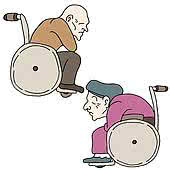
It’s hard to believe that anyone would cause harm to the elderly anywhere, specifically in a nursing home, but the sad truth is that it happens. From 2015-2016, investigators found 134 cases of abuse of nursing home residents. Most nursing home residences hold strict codes to ensure these abuses don’t happen, but this article is meant to highlight four warning signs of negligence for you to use as a guideline in protecting your loved ones.
Staff Shortages
A big red flag should go up if you notice a scarce amount staff members working in a senior home. When a facility is short-staffed, it is common for staff members to become overwhelmed from not being able to keep up with workflow and start becoming neglectful to their patients by cutting corners, according to the Nursing Home Abuse Center. Without the adequate amount of staff members, any home runs the risk of committing medical malfeasance, such as poor patient hygiene, bed sores, malnutrition, dehydration, etc..
Bedsores
Bedsores, or pressure ulcers, naturally occurs with infirmed patients who cannot move around without assistance. In a nutshell, a bedsore is tissue damage that, in its beginning stages, looks like a bruise on the upper-layer of the skin. At its worst, stage 4, bedsores become an odorous, open sore exposing a patient’s tendons, muscles, and bones. Regardless, bedsores occur from a patient not being moved or rotated in their gurney, which is a blatant sign of neglect. The Nursing Home Abuse Guide lays out a number of commonly affected body parts that should be scanned for pressure ulcers.
Malnutrition
“Malnutrition is defined as the condition that results from eating an unbalanced diet that lacks the proper amount of nutrients or has too many of certain kind of nutrients.” This is not always the home’s fault, as “elderly people are prone to appetite loss,” says the Nursing Home Abuse Center. Nevertheless, staff members are paid to closely monitor sudden changes of this sort and should make the necessary adjustments to remedy the situation, as well as communicating the issue. As per the Nursing Home Abuse Center, signs of malnutrition are: weight loss, fatigue, dizziness, tooth decay, mental decline, fragile bones, dry and ashen skin, muscle loss, weakness, bloated abdomen, confusion, decreased organ function and swollen or bleeding gums.
Dehydration
As stated by medical professionals, the elderly have a harder time conserving water, so they are at a higher risk of dehydration. What’s more, sense of thirst diminishes in their later years. Some obvious symptoms to look for include: “extreme thirst, less frequent urination, dark-colored urine, fatigue, dizziness, and confusion.” A more thorough way to check hydration levels is to order a blood test.
In Conclusion
There are certainly more warning signs of elder neglect; however, these four are some of the easiest to spot. If you suspect abuse, be sure to bring it to the attention of adminstrators & if needed, contact the authorities and file a grievance with the appropriate state agency.